With each passing year, Google relies more heavily on structured data in their search engine results pages (SERPs).
This fact is well-documented and has caused quite a stir in the SEO community. As Google delivers more information directly to the user, the actual websites that provided that data are seeing fewer clicks.
This post from Rand Fishkin, Founder of Sparktoro, showed that two-thirds of all Google searches today do not result in a click-through to a listed website went viral and fostered a lot of discussion on social media in early 2021.
So much discussion that Google was forced to release a response.
They argued that while they didn’t fully refute that most searches do not result in a click-through, they downplayed the impact that their rich results were having. They pointed out that searchers often refine their query across multiple searches or connect with local businesses directly through Google search, never requiring that they click-through to the website.
Those are good points, but the fact does remain that Google is increasingly relying on data from websites in their listings — both structured and unstructured — to deliver information directly to users.
Even more alarming to some was the apparent growth in the usage of structured data over time. That Sparktoro blog post cited a 14% increase in just one year.
So while there is some debate within the SEO community about the overall extent of structured data’s role, it is still clear that it does play a large role, and is likely to become more significant over time.
In this article, I’ll dive into what structured data is, how it is used by Google, why it is important, and take a look at what the future of structured data in search optimization might look like.
What is Structured Data?
Structured data is a way of arranging and categorizing the data on your website to make it easier for search engines to read, understand, and utilize in their results pages.
Structured data is meant to be mutually beneficial. Companies and websites get more control over what data is pulled from their website and can check it for accuracy, and Google gets accurate, reliable data that they can deliver to their users. Companies get to provide information about their company, products, and content directly on the search results page, and Google gets to provide a better experience to their users.
To deliver structured data to Google, you do so using a library of vocabulary and classifications that is called Schema detailed at Schema.org. This provides a series of pre-defined tags and properties that you can use to mark various pieces of information on your website — product descriptions, reviews, job postings — and make them easy for search engines to find and use.
But structured data and Schema.org are not exclusive to Google. Other search engines like Bing, Yandex, and Yahoo worked with Google collectively to create a shared language that helped all of them to better read and understand your website. Schema.org recently released their own schema markup validator tool.
This way, creating your structured data snippets help the content that you deliver to be leveraged by all relevant search engines. It’s a win-win.
Why Is Structured Data Important for SEO?
Structured data has played varied levels of importance in SEO over the years. Early on, simply providing a meta title and meta description might be enough to signal enough relevance to Google to rank your website highly for targeted keywords.
But of course, that left search engine results pages ripe for gaming, and as time went on, Google and other search engines had to take a more sophisticated approach to evaluate content and rank websites.
The short answer is yes, structured data is important for SEO and only becoming more important over time.
Implementing Schema.org structured data alone may not be enough to give you a rankings boost, but it does increase the chances of Google finding relevant information on your site that they want to share with their users.
Implementing it even now will give you a head start on the competition. Many websites have failed to fully build out their structured data and as a result, are likely hurting their visibility in the long term. More than one-third of all websites have no structured data available.
Structured data gives search engines the opportunity to use rich listings to deliver information directly to their users. That snippet may or may not convince a user to click through.
But there have been several case studies published that show that obtaining rich snippets and featured listings can have a big impact on click-through rate.
- Ben Goodsell found that the click-through rate on a featured page increased from 2% to 8% once it was featured in the answer box on the SERP. Their revenue from the listing increased by 677%. This is an older study from 2015, so user behavior is likely to have changed since then. Still, it goes to show that while featured snippets may decrease the number of total click-throughs on a SERP page, the featured website may still stand to benefit.
- In a more recent study, Eric Enge of Perficient saw a 20–30% increase in traffic for their website, ConfluentForms.com, while they held the featured snippet for a targeted search query.
A study by Ahrefs in 2017 found that 12.3% of search queries included a featured snippet, and a vast majority of those showed up in the first position.
Even if users do not click through to your website, there is some visibility and awareness value in being the company that provides the featured snippet.
How Google Uses Structured Data
Google has expanded the number of ways in which they use structured data. Over time, Schema.org has been expanded to add new specific tags – such as for books or movies, for example.
Today, these are the different rich results in search that come from structured data:
- Article
- Book
- Breadcrumbs
- Carousel
- Critic review
- Dataset
- Employer aggregate rating
- Event
- Fact check
- FAQ
- How-to
- Image license
- Job posting
- Job training
- Local business
- Logo
- Movie
- Estimated salary
- Podcast
- Product
- Q&A
- Recipe
- Review snippet
- Sitelinks search box
- Software app
- Speakable
- Subscription
- Video
That’s a lot of different types of structured data. And Google and other partners are constantly expanding the program, so this list growing is a safe bet in the future.
Google takes this structured data and represents it in multiple ways in the search results.
Let’s view some of the different ways that structured data is displayed as ‘rich snippets’ in the SERPs.
Rich Results
Rich results are pieces of information and features that are shown on a search engine results page. Breadcrumbs are a very basic example of this. Ratings & reviews, product descriptions, and availability would be other common rich results that are often appended.
Let’s take a look at an example. In the search results for “Fujifilm X-S10,” a popular digital camera, Google pulls structured data from websites to create rich results that provide additional context for the searcher.
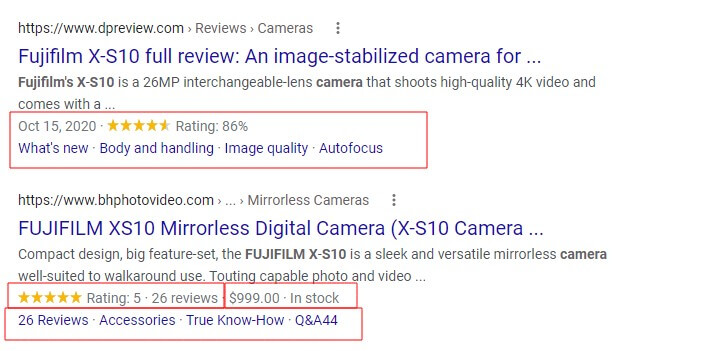
Rich results like this are not limited to product searches and are seen across many different types of searches.
Mobile Rich Results
Rich results are even more common on mobile than they are on desktop. This is likely because mobile searches are more likely to take on the form of a question, a type of query that is perfect for Google to deliver structured data. Mobile searchers are also less likely to seek information from multiple sources.
Certain types of searches — products, local businesses (like restaurants), movies, flight information, etc. — are particularly heavy on rich snippets.
For Google, the more activities that they can keep their customers doing inside of the search engine, the better. For instance, you can reserve a seat at your favorite restaurant or book a flight directly through Google now. These features are driven by rich results.
Mobile rich results are typically touch-friendly and are swipeable, which differ from the desktop results.
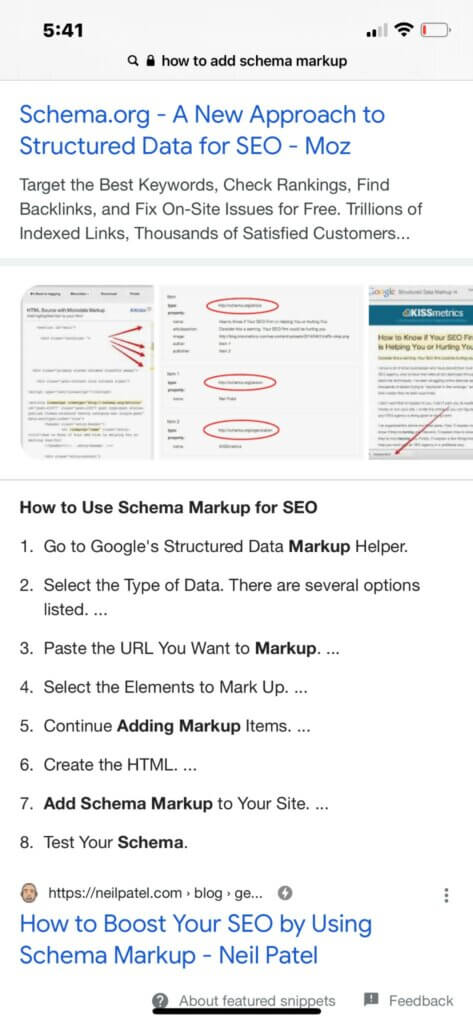
Knowledge Graph
The Knowledge Graph is the large block of data and information on the right-hand side of Google search results pages.
Often, when people refer to the reasons for “clickless searches,” the Knowledge Graph is one of the primary culprits that they are referring to because the Knowledge Graph allows Google to quickly deliver information to users without directing them to a third-party source.You probably have seen it — and even used it — many times without even thinking about it.
Let’s say you wanted to learn more about the actor Timothy Olyphant and searched his name, you would see something like this in the Knowledge Graph:

It’s easy to see why the Knowledge Graph would lead to clickless searches that in previous years would have resulted in a click-through to an authority website.
For example, in the search above, the Knowledge Graph listing for Timothy Olyphant answers some of the most common questions asked about him in search:
- What does Timothy Olyphant look like?
- How old is Timothy Olyphant?
- What movies has Timothy Olyphant been in?
- What TV shows has Timothy Olyphant been in?
- How tall is Timothy Olyphant?
- Who is Timothy Olyphant married to?
Those are some of the most searched questions relating to him and all of that information is made readily available.
Additionally, if you make a more specific search, you are likely to see a rich result answer at the top of the SERP.

We’ve covered no-click searches, but what about no-search searches?
Google makes some information available while the user is typing in their search.

Boom. Before the user even finishes typing their search, Google has anticipated where they were going and provided the desired information.
It’s easy to see how many of these types of searches would not require a click-through to an authority website for the end-user.
Google argues that searches for “quick facts” — such as an actor’s age or height — shouldn’t necessitate a click-through to a website. By quickly providing that information, they provide a better experience to the user.
Then, Google would argue that often, a search that is satisfied by the information provided in their Knowledge Graph or rich snippets may prompt additional searches, such as:
- Justified TV Show Review
- Who Does Deadwood Star
- Where Can I Stream Santa Clarita Diet?
Or, they could simply click objects on the Knowledge Graph to refine their search. In the example above, clicking a movie cover, for instance, would start a search for that particular movie.
The Knowledge Graph shows up on between 8-15% of searches on desktop and mobile.
Featured Snippets
Technically, featured snippets should not be featured in this article because they aren’t necessarily related to structured data, but rather unstructured data, because they pull content directly from the body content of your website.
Additionally, “Featured Snippets” are technically rich results that we covered earlier, but have a few key distinctions that warrant their inclusion.
Featured snippets are typically content pulled from a website that directly answers a search question.
Featured snippets can appear in multiple places. The most visible and therefore most-coveted is the single featured snippet at the top of a search result. They most often show here, but may also show farther down the page as well.
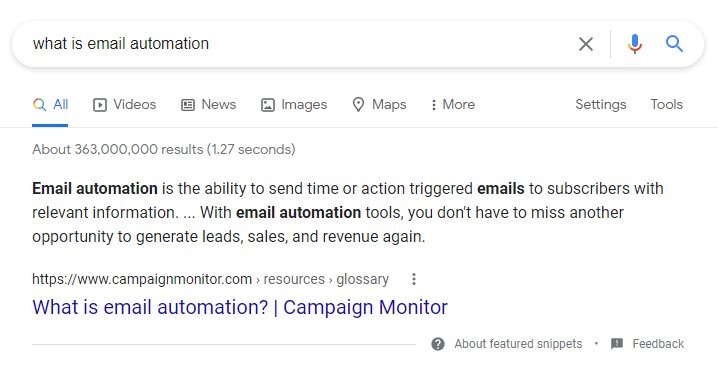
Sometimes, the featured snippet will feature an image from your content.

Notice how Google pulls information directly from the content, and may even aggregate headlines from your article into a ordered list, like above.
Searchers see your content highlighted, and are provided with the option to click-through to your website.
This provides a happy balance. Yes, winning the featured snippet may lead to more no-click searches. But it also puts your brand front-and-center over the competition and could drive significant traffic from higher-volume searches.
And just because you are listed in the featured snippet, doesn’t mean that other pages or posts on your website can’t be included in the standard top-10 rankings on the same page. Owning a featured snippet can be foundational to growing your visibility for certain keywords.
Snippets can also show up in other places, like the “People Also Ask” section.
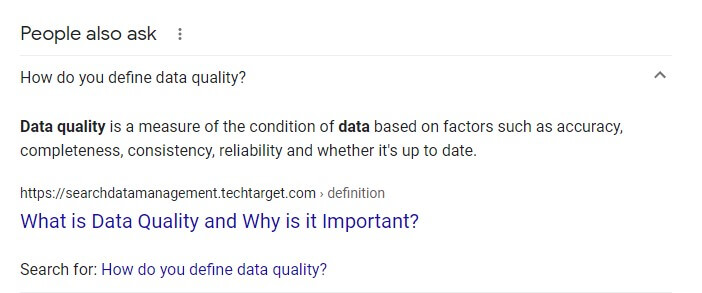
Featured snippets are a coveted tool for growing your visibility on key customer searches.
With a featured snippet or PAA rich result, the content on your page has to answer key questions from searchers. If a competitor has one, consider how you can out-do them by providing a better, more succinct description for a given snippet.
Identifying Opportunities for Structured Data
If you have hundreds or thousands of pages without significant structured data built out, then updating can represent a pretty big undertaking.
For larger websites, it might be a better idea to identify your most important pages. Use analytics to determine your target pages or target categories and go from there.
To identify these opportunities, you’ll have to conduct a quick audit of your structured data, if you have any to audit.
1. Audit Your Structured Data
Your site may already have structured data implemented. You can check whether Google has found this markup and if there are any errors to address in Google Search Console (GSC). Keep in mind that Google will readily penalize sites that abuse the structured data system to inject non-relevant content.
Navigate to the Google Search Console’s “Enhancements” section. All structured data markup on your website will appear here.
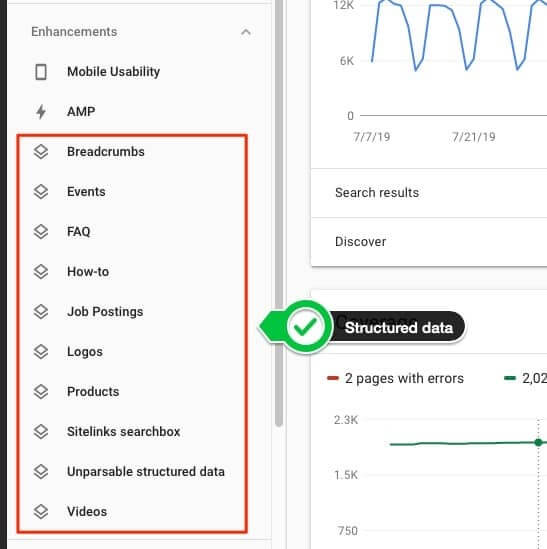
The reports in this section will point out pages that have errors, or warnings, which act more like suggestions for improving your visibility. Only errors require immediate attention.
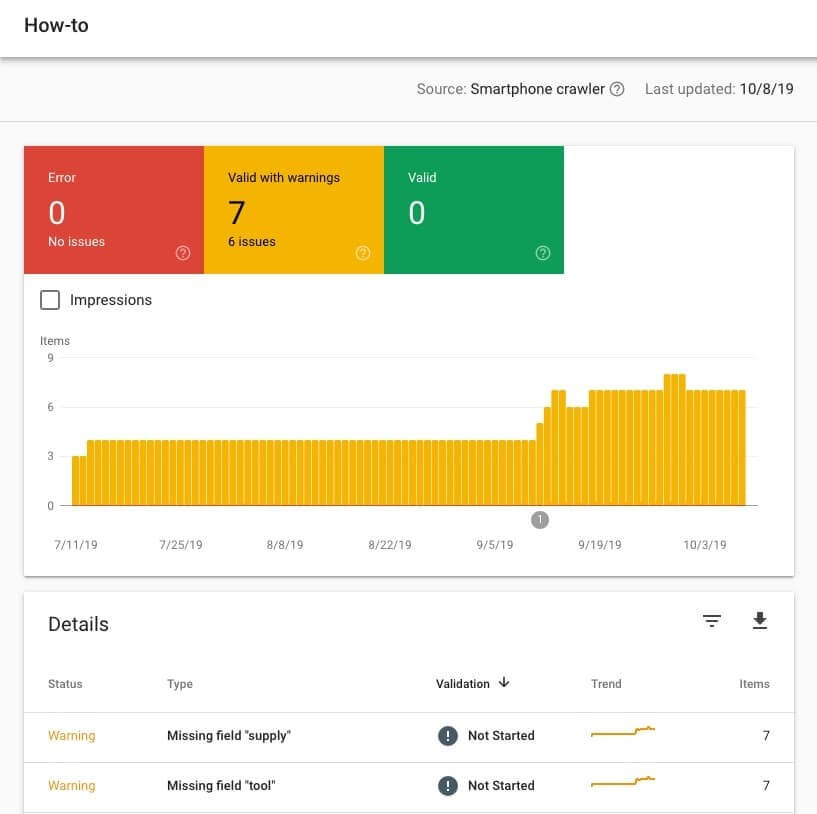
If you select the details of a Warning, Google Search Console will provide more information about the specific warning and affected pages.
After making improvements, you can validate your structured data using the Rich Results Test tool.
2. Audit Content and Target Keywords for Opportunity
Then, take stock of your pages and see what pages present an opportunity for improving your visibility in the SERPs through structured data.
Ahrefs is a tool that can help with this. Their system not only tracks the rankings of your pages but also allows you to examine which keywords you are ranking for contain one of the SERP features outlined in this article.
Note which pages rank for keywords that are using structured data and rich results in the search results. Then, you can prioritize the pages that are going to have the most impact.
Map all content types to the correct SERP features and ensure that you have the correct markup in place. In time, you will likely see your resulting SERP features grow, improving your visibility within your industry.
Ensure that all page types receive the relevant markup — product pages use Product markup, product reviews use Review markup, location information uses LocalBusiness markup.
You can use Google’s Structured Data Markup Helper to help you create and edit your existing markup.
Schema Markup Types & Examples
There are three formats of schema markups that are used in structured data for search engines.
- JSON-LD
- Microdata
- RDFa
Google’s preferred Schema markup is JSON-LD, but you are not penalized for using microdata or RDFa.
Let’s take a quick look at the differences between the markup types and provide a quick example of the markup itself.
JSON-LD
JSON-LD has an advantage over other Schema markup types because it is not present in the body of the page. Data is delivered through JSON script in the header. This is ideal for loading times and for the organization.
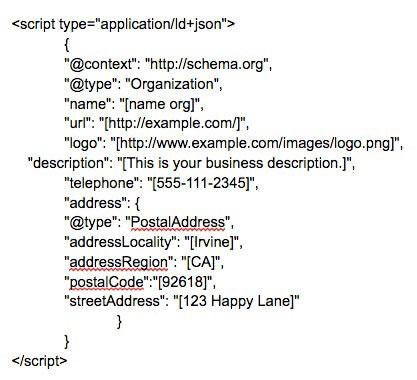
Microdata
Microdata is a set of tags that allows you to mark up your web page. These tags are inserted directly into the HTML of the page.
Each set of tags will include “itemscope”, “itemtype” and “itemprop”.
- itemscope: identify what item is being referenced.
- Itemtype: identifies the type of item the microdata is referencing (like a local business, recipe, or movie showtime).
- itemprop: to markup the data for each property.

RDFa
RDFa is similar to Microdata. Like Microdata, RDFa uses tags inline with the existing HTML.
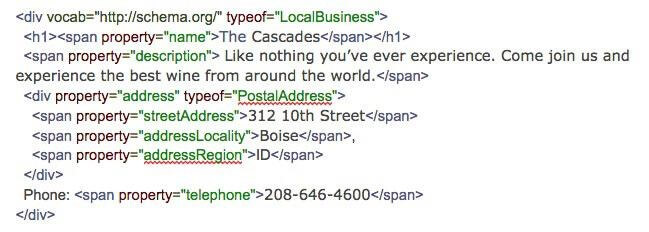
Why Is Google Not Displaying My Structured Data?
Ideally, you want to take advantage of as much structured data as possible.
But even if you have every possible piece of markup in place, there will always be times when your structured data doesn’t appear in Google as you would hope.
It is important to keep in mind that Google has no obligation to display your rich data just because you add it to your website. They may choose to display a competitor’s data instead.
Nor are they obligated to keep it there once it has been displayed. Rich results are constantly changing in searches as user intent changes and Google gathers more data.
Google is constantly testing new approaches. It could be that your particular page tends to convert better and keep visitors engaged longer when the rich results are not displayed. They may turn it on or off for specific results, or for all of the results for a specific keyword. These tests are mostly handled by machine learning and bots, but some bigger tests are human-produced.
Without knowing how Google’s backend experiments are performing, there is no way to gauge why your structured data is not being used for a given search result.
With that said, there are some common technical reasons why your structured data may not be identified or displayed by Google and other search engines, including:
- Your data doesn’t meet quality standards. Google requires that structured data provided be up to date and relevant. No illegal content may be shared through structured data.
- Your structured data markup is incorrect. This is very common. Make sure to use Searchbloom’s Schema Markup Generator Tool or the Schema Markup Validator tool to evaluate your markup for mistakes.
- Using multiple markup languages. You may only use one markup language at a time on the same URL. Try to avoid JSON-LD, Microdata, and RDFa. Google’s preference is JSON, so it may be wise to stick with that.
- Don’t use organizational markup on every page. Organizational markup tells Google and other search engines important information about your company. But it only needs to be included once on your entire website — often the homepage or “about” page. Using the same markup on every page signals spammy or low-quality practices and should be avoided.
- Your site is not in good standing with Google. If Google does not regard your website as a reliable authority, then they are unlikely to use your structured data in their rich results.
- Your sitemap is not signaling to Google that updates have been made. Ensure that your XML sitemap uses the <lastmod> tag to signal that pages need to be reindexed.
- Not enough time has elapsed. Structured data won’t begin appearing instantly. Allow several weeks before you begin to worry about whether or not it will show up at all.
Typically, any serious additions to your website should result in some of your structured data being used in rich results if your website is in good standing.
Forecasting the Future Importance of Structured Data
If the last decade is any indication, businesses would be smart to embrace structured data now.
Google has placed increased importance on structured data at every turn, and you can bet that it will only become more important as technologies like voice search and IoT devices become more commonly used and user search habits change.
Embracing structured data for rich results and trying to obtain featured snippets can help increase your brand’s visibility, increase your organic traffic, and put you in a better position to weather the growth in no-click searches.
While there will always be updates to Schema markup, building out your structured data now rather than later will make those updates less painful in the future.


